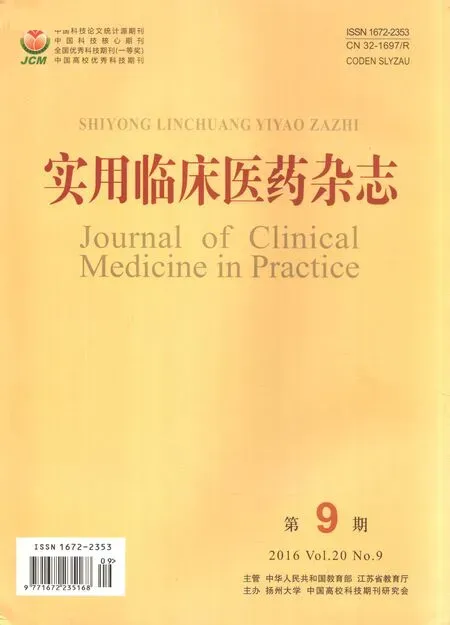鹽酸右美托咪定對(duì)連續(xù)硬膜外聯(lián)合全麻下婦科腹腔鏡手術(shù)患者全麻蘇醒期的影響
陶學(xué)有, 田華友, 李曉明, 左美娟, 翟海霞
(揚(yáng)州大學(xué)醫(yī)學(xué)院附屬揚(yáng)州市婦幼保健院 麻醉科, 江蘇 揚(yáng)州, 225001)
?
鹽酸右美托咪定對(duì)連續(xù)硬膜外聯(lián)合全麻下婦科腹腔鏡手術(shù)患者全麻蘇醒期的影響
陶學(xué)有, 田華友, 李曉明, 左美娟, 翟海霞
(揚(yáng)州大學(xué)醫(yī)學(xué)院附屬揚(yáng)州市婦幼保健院 麻醉科, 江蘇 揚(yáng)州, 225001)
摘要:目的觀察鹽酸右美托咪定對(duì)硬膜外聯(lián)合全麻下婦科手術(shù)患者全麻蘇醒期的影響。方法40例婦科手術(shù)患者隨機(jī)分為鹽酸右美托咪定組(D組)和丙泊酚組(P組)。記錄實(shí)施麻醉前(T1)、進(jìn)入蘇醒室時(shí)(T2)、蘇醒時(shí)(T3)、拔除氣管導(dǎo)管時(shí)(T4)、離開蘇醒室時(shí)(T5)患者的HR、MAP和SpO2值以及麻醉蘇醒時(shí)間、拔除氣管導(dǎo)管時(shí)間、術(shù)中知曉例數(shù)、惡心嘔吐和寒戰(zhàn)的發(fā)生例數(shù)。結(jié)果2組T1時(shí)間點(diǎn)各指標(biāo)均無(wú)顯著差異(P>0.05)。2組T2、T3、T4和T5時(shí)HR和MAP,蘇醒時(shí)間、拔管時(shí)間、惡心嘔吐和寒戰(zhàn)的發(fā)生例數(shù)有顯著差異(P<0.05)。結(jié)論鹽酸右美托咪定應(yīng)用于連續(xù)硬膜外聯(lián)合全麻患者的全麻蘇醒期血流動(dòng)力學(xué)更加穩(wěn)定,可以明顯減少惡心嘔吐等不適。
關(guān)鍵詞:蘇醒期; 全麻; 不良反應(yīng); 右美托咪定; 血流動(dòng)力學(xué); 硬膜外阻滯
婦科腹腔鏡手術(shù)過(guò)程中為了維持良好的手術(shù)視野,常常采用一定壓力的氣腹。氣腹過(guò)程可以壓迫腹腔臟器和牽拉膈肌,可引起患者蘇醒延遲、惡心嘔吐、疼痛等不良反應(yīng)[1]。鹽酸右美托咪定具有良好的鎮(zhèn)痛、鎮(zhèn)靜作用,并且可以提高全麻患者蘇醒過(guò)程的舒適度[2]。本研究探討鹽酸右美托咪定對(duì)連續(xù)硬膜外麻醉聯(lián)合全麻下婦科腹腔鏡手術(shù)患者全麻蘇醒期相關(guān)指標(biāo)的影響,現(xiàn)報(bào)告如下。
1資料與方法
1.1一般資料
本研究項(xiàng)目通過(guò)本院醫(yī)學(xué)倫理委員會(huì)批準(zhǔn),并獲得患者知情同意。選擇本院連續(xù)硬膜外麻醉聯(lián)合全麻下婦科腹腔鏡手術(shù)患者40例,年齡25~45歲,美國(guó)麻醉醫(yī)師(ASA)分級(jí)Ⅰ~Ⅱ級(jí)。患者既往體健,無(wú)藥物過(guò)敏史,無(wú)循環(huán)呼吸系統(tǒng)疾病,無(wú)婦科腹腔鏡手術(shù)禁忌證。隨機(jī)將患者分為異丙酚組(P組)和鹽酸右美托咪定組(D組)各20例。2組一般資料比較無(wú)顯著差異(P>0.05),見表1。

表1 2組患者一般資料比較
1.2麻醉方法
患者手術(shù)前禁食12 h、禁水8 h。入手術(shù)室后常規(guī)開放靜脈通道,監(jiān)測(cè)患者心電圖(ECG)、脈搏血氧飽和度(SpO2)、無(wú)創(chuàng)血壓(BP)和腦電雙頻指數(shù)(BIS)。D組患者麻醉操作前給予鹽酸右美托咪定0.5 μg/(kg·h)靜脈持續(xù)泵注30 min。選擇L2-3或L3-4行連續(xù)硬膜外麻醉,置管深度為3.5~4.5 cm, 經(jīng)硬膜外導(dǎo)管給予1%鹽酸利多卡因注射液,待確定麻醉平面后,常規(guī)全麻誘導(dǎo)咪達(dá)唑侖0.1 mg/kg, 芬太尼0.04 μg/kg, 丙泊酚1 mg/kg, 維庫(kù)溴銨0.10 mg/kg全麻誘導(dǎo), 2 min后氣管插管,控制呼吸,潮氣量(Vt)8~10 mL/kg, 呼吸頻率(f)13 次/min,吸呼比(I∶E)1∶2,調(diào)節(jié)呼氣末二氧化碳分壓(PetCO2)為35~40 mmHg。P組除不使用鹽酸右美托咪定泵注,其他各項(xiàng)與D組均相同。手術(shù)結(jié)束患者入蘇醒室后氣管拔管,拔管指征為: ① 自主呼吸恢復(fù),潮氣量足夠; ② 吞咽,嗆咳反射基本恢復(fù); ③ 患者完全清醒,呼之能應(yīng),并能正確點(diǎn)頭示意; ④ 呼吸空氣觀察20 min,SpO2不低于95%; ⑤ 單臂抬起6 s以上; ⑥ 氣道及口內(nèi)分泌物基本清除干凈。
1.3監(jiān)測(cè)指標(biāo)及記錄
記錄患者入蘇醒室及拔管前后的相關(guān)指標(biāo): ① 患者麻醉蘇醒時(shí)間(min); ② 拔除氣管導(dǎo)管時(shí)間(min); ③ 術(shù)中知曉例數(shù); ④ 惡心、嘔吐和寒戰(zhàn)的發(fā)生例數(shù); ⑤ 記錄入室后實(shí)施麻醉前(T1)、進(jìn)入蘇醒室時(shí)(T2)、蘇醒時(shí)(T3)、拔除氣管導(dǎo)管時(shí)(T4)、離開蘇醒室時(shí)(T5)患者的HR、MAP和SpO2。
1.4統(tǒng)計(jì)學(xué)分析
采用SPSS 11.5軟件進(jìn)行統(tǒng)計(jì)學(xué)分析,重復(fù)測(cè)量資料采用方差分析,計(jì)量數(shù)據(jù)采用均數(shù)±標(biāo)準(zhǔn)差表示。同時(shí)間點(diǎn)組間比較采用t檢驗(yàn),計(jì)數(shù)資料采用卡方檢驗(yàn),P<0.05為差異有統(tǒng)計(jì)學(xué)意義。
2結(jié)果
T1時(shí)間點(diǎn),D組與P組HR、MAP和SpO2值比較,差異均無(wú)統(tǒng)計(jì)學(xué)意義(P>0.05);T2、T3、T4和T5時(shí)間點(diǎn),D組與P組HR和MAP比較,差異均有統(tǒng)計(jì)學(xué)意義(P<0.05),SpO2差異無(wú)統(tǒng)計(jì)學(xué)意義(P>0.05)。見表2。

表2 2組患者各時(shí)間點(diǎn)血流動(dòng)力學(xué)指標(biāo)比較
與P組比較, *P<0.05。
D組與P組蘇醒時(shí)間和拔管時(shí)間比較,差異有統(tǒng)計(jì)學(xué)意義(P<0.05), 惡心、嘔吐和寒戰(zhàn)的發(fā)生例數(shù)比較差異有統(tǒng)計(jì)學(xué)意義(P<0.05), 術(shù)中知曉發(fā)生例數(shù)差異無(wú)統(tǒng)計(jì)學(xué)意義(P>0.05)。見表3。

表3 2組患者蘇醒過(guò)程相關(guān)指標(biāo)比較
與D組比較, *P<0.05。
3討論
腹腔鏡技術(shù)具有微創(chuàng)、術(shù)后恢復(fù)快等優(yōu)點(diǎn),在臨床中應(yīng)用越來(lái)越廣泛[3]。但腹腔鏡手術(shù)過(guò)程對(duì)機(jī)體的循環(huán)和呼吸功能有很強(qiáng)烈的干擾,氣腹是最主要的原因,所以一般手術(shù)過(guò)程將氣腹的壓力控制在14 mmHg[4-5]。氣腹過(guò)程增加了患者腹腔壓力,膈肌上抬,肺功能殘氣量減少,影響氣體交換,動(dòng)脈二氧化碳分壓升高。另外氣腹還可以導(dǎo)致患者靜脈回流增加,心臟前、后負(fù)荷增加,激活機(jī)體內(nèi)分泌系統(tǒng),外周血管阻力和血流動(dòng)力學(xué)變化[6-7]。這一系列的生理病理變化嚴(yán)重影響了患者麻醉手術(shù)的恢復(fù)過(guò)程的舒適度[8]。
椎管內(nèi)麻醉過(guò)程中,由于交感神經(jīng)阻滯,副交感神經(jīng)興奮,消化道蠕動(dòng)增強(qiáng),患者常常發(fā)生惡心、嘔吐等并發(fā)癥。另外,全麻對(duì)患者體溫調(diào)節(jié)中樞的抑制作用,患者在蘇醒期會(huì)發(fā)生寒戰(zhàn)反應(yīng)。鹽酸右美托咪定是α2受體高選擇性受體阻滯劑,具有良好的鎮(zhèn)痛、催眠、鎮(zhèn)靜作用[9-10]。對(duì)循環(huán)系統(tǒng)主要表現(xiàn)為產(chǎn)生劑量依賴性的心率和血壓變化,通過(guò)對(duì)交感神經(jīng)的抑制作用,降低機(jī)體的應(yīng)激反應(yīng),使圍術(shù)期血流動(dòng)力學(xué)更加穩(wěn)定[11]。近年來(lái),鹽酸右美托咪定被運(yùn)用于神經(jīng)外科手術(shù)過(guò)程的“術(shù)中喚醒”,患者的蘇醒過(guò)程拔管時(shí)間短,無(wú)呼吸抑制[12],可以減少氣管拔管前后心率、血壓波動(dòng)[12-13]。另外,鹽酸右美托咪定通過(guò)作用于體溫調(diào)節(jié)中樞的K+通道,導(dǎo)致細(xì)胞去極化,抑制機(jī)體寒戰(zhàn)反應(yīng)的發(fā)生,提高了患者蘇醒過(guò)程的舒適度[14]。本研究發(fā)現(xiàn),鹽酸右美托咪啶運(yùn)用于連續(xù)硬膜外聯(lián)合全麻下婦科腹腔鏡手術(shù)時(shí),通過(guò)對(duì)患者蘇醒期血流動(dòng)力學(xué)和蘇醒相關(guān)指標(biāo)監(jiān)測(cè),表明鹽酸右美托咪啶組患者具有良好的血流動(dòng)力學(xué)穩(wěn)定性,患者的蘇醒時(shí)間縮短,并且不適反應(yīng)如寒戰(zhàn)、惡心、嘔吐等發(fā)生例數(shù)明顯減少。
綜上所述,鹽酸右美托咪定運(yùn)用于連續(xù)硬膜外麻醉聯(lián)合全麻下婦科腹腔鏡手術(shù)中,對(duì)改善患者蘇醒期的血流動(dòng)力學(xué)穩(wěn)定性和舒適度具有良好的效果。
參考文獻(xiàn)
[1]Mouton W G, Beesell J R, Otten K T, et al. Pain after laparoscopy[J]. Surg Endose, 1999, 13: 445-448.
[2]Khan Z P, Fergu son C N, Jones R M. A lpha-2 and imidazoline recepter agonists[J]. Anaesthesia, 1999, 54(2): 146-165.
[3]劉彥. 實(shí)用婦科腹腔鏡手術(shù)學(xué)[M]. 北京: 科學(xué)技術(shù)文獻(xiàn)出版社, 1999: 7-9.
[4]陳琦, 陶靜茹, 尤新民. 膽囊切除術(shù)中PHC 對(duì)血流動(dòng)力學(xué)、肺內(nèi)分流和氧合的影響[J]. 上海第二醫(yī)科大學(xué)學(xué)報(bào), 2004, 11: 952-954.
[5]劉小艷, 蔡秋娥, 羅玉華. 婦科腹腔鏡手術(shù)氣腹及體位并發(fā)癥問(wèn)題的循證護(hù)理[J]. 腹腔鏡外科雜志, 2010, 15(11): 879-880.
[6]MANN C, BOCCARA G, POUZERATTE Y, et al. The relationship among carbon dioxide pneumopefitoneum, Vasopressin release and hemodynamic changes[J]. Anesth Analg, 1999, 89 (2): 278-283.
[7]O′LEARY E A, HUBBARD K, TORMEY W, et al. Laporescopic cholecysteetomy: hem odynamie and neurendoerine responses after pneumoperitoneum and changes in position[J]. Br J Anaesth, 1996, 76(5): 640-644.
[8]Lauretti G R, Azevedo V M. Intravenous ketamine or fentanyl prolongs postoperative analgesia after intrathecal neostigm ine[J]. Anesth Analg, 1996, 83: 766-770.
[9]BHANA N, GOAK L, MCCLELLAN K J. Dexmedetomidine[J]. Drugs, 2000, 59: 263-268.
[10]Coull J T, Jones M, Egan T, et al. Attentional effects of noradrenaline vary with arousal level: selective activation of thalamic pulvinar in humans[J]. Neuro Image, 2004, 22: 315-322.
[11]CHU K S, WANG F Y, HSU H T, et al. The effectiveness of dexmedetomidine infusion for sedating oral cancer patients undergoing a wake fibreop tic nasal intubation[J]. Eur J Anaesthesiol, 2010, 27(1): 36-40.
[12]TANSKANEN P E, KYTT A V, RANDELL T T, et al. Dexmedetomidine as an anaesthetic adjuvant in patientsundergoing intracranial tumour surgery: a doubleblind, randomized and placebo controlled study[J]. Br JAnaesth, 2006, 97(4): 658-665.
[13]Arpino P A, Kalafatas K, Thompson BT. Feasibility of dexmedetomidine in facilitating extubation in the intensive care unit[J]. ClinPharma Therapeut, 2008, 33(1): 25-30.
[14]Tobias J D. Bradycardia during dexmedetomidine and therapeutic hypothermia [J]. Intensive Care Med, 2008, 23: 403-408.
Effect of dexmedetomidine on recovery period of general anesthesia in patients with laparoscopic surgery by continuous epidural anesthesia combined with general anesthesia
TAO Xueyou, TIAN Huayou, LI Xiaoming, ZUO Meijuan, ZHAI Haixia
(DepartmentofAnesthesiology,YangzhouMaternalandChildHealthCareHospitalAffiliatedtoMedicalCollegeofYangzhouUniversity,Yangzhou,Jiangsu, 225001 )
ABSTRACT:ObjectiveTo explore the effect of dexmedetomidine (DEX) on recovery period of general anesthesia in patients with laparoscopic surgery by continuous general epidural anesthesia combined with general anesthesia. MethodsForty patients were randomly divided into group D (dexmedetomidine) and group P (propofol). The hemodynamic indexes such as HR, SpO2 and MAP were recorded at the time points of before anesthesia (T1), living in the recovery room (T2), analepsis (T3), extubation (T4), leaving the recovery room (T5), and the anesthesia recovery time, extubation time, intra-operative awareness, the cases of nausea and vomiting and chills were compared as well. ResultsThere were no significant differences of indexes between two groups at T1(P>0.05). There were significant differences in HR, MAP and incidences of anesthesia recovery time, extubation time, the cases of nausea and vomiting and chills at T2, T3, T4and T5 between two groups(P<0.05). ConclusionApplication of dexmedetomidine in recovery period of general anesthesia in patients with laparoscopic surgery by continuous general epidural anesthesia combined with general anesthesia can maintain stability of hemodynamics and reduce the adverse reactions such as nausea and vomiting.
KEYWORDS:recovery period; general anesthesia; adverse reactions; dexmedetomidine; hemodynamics; epidural block
中圖分類號(hào):R 614
文獻(xiàn)標(biāo)志碼:A
文章編號(hào):1672-2353(2016)09-076-03
DOI:10.7619/jcmp.201609022
收稿日期:2015-12-10

